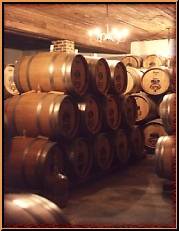Related
Products
 How Barrels are Made
How Barrels are Made
The art of barrel making, known as cooperage, is an ancient skill. Despite improvement from modern research, analysis, machinery and wood selection techniques, the actual barrel making process has changed very little over the years and is extremely time intensive. To achieve the highest standards of quality, most of the work must still be done by hand by a highly skilled cooper. The following information is adapted from the famous French cooperage Seguin Moreau, where many premium California wineries � including Clos du Bois � source French oak barrels.
Every season, when trees are felled, experts from the cooperage are on hand to select the best oak wood for use in the manufacture of barrels and vats. This selection is the initial phase that essentially determines the quality of the finished product.
The oak is examined both before and after being cut, and wood is selected based on many criteria, including tree shape and growing conditions. These factors determine the textural variety of wood fibers, the fineness of its grain and its tannin content. Tight grain and fine tannin content are found in the best wood.
The logs must be hand split to preserve wood grain without breaking wood veins, which is essential for creating impermeable barrels. The oak log is first split in two, then into quarters to obtain wood for the oak staves (called merrain). After splitting and planing, the stave wood is stored outside in tiers. Exposed to air and water, the wood is naturally aged by the weather for several years. During the aging process, the development of sugars and acids are monitored.
After aging, the staves are formed by machines into the proper shape and form for barrel assembly. After they are cut to the proper length, they are tapered at each end and beveled. Then they are planed on the outside, slightly hollowed on the inside and jointed by high precision machining.
After being inspected and selected, the staves are given to a cooper for assembly. At this essential stage of the manufacturing process, man steps in. The craftsman with irreplaceable experience and, above all, appreciation for work well done now adds his personal touch. The sharp-eyed cooper selects his staves, setting aside those that do not suit him. Then he assembles the staves inside a metal hoop that serves as the assembly jig. This operation, so spectacular in its speed and precision, is what the cooper calls the "mise en rose" or "raising the barrel."
Solidly held in place by three metal hoops that have been forced into place, the "rose" is then subjected to a trial by water and fire in the workshop, where it takes its final shape. Repeating movements that are part of the most ancient tradition of his art, the cooper seals joints by passing a wet cloth inside and outside the staves, then heating the barrel over a wood fire for approximately 30 minutes. Rendered flexible by heat and humidity, the wood fiber can now be bent by the cooper, who uses a winch to gradually arch the staves and tighten them to obtain the shape of the barrel body. The body is held trussed in place like this until the metal hoops are definitely placed.
The length of heating results in a "toast level" on which the flavors of the wine aged in the barrel will partially depend. During the heating of the staves, some substances of the wood are caramelized and develop a multitude of aromas, such as vanilla, fresh bread, buttered bread, or a touch of nut, that will be found in the final taste of the wine. Toast level will be adjusted according to the customers' requests: light, medium or heavy toast.
After the bending and heating of the staves, a very precise machining step is necessary to trim the ends of the staves and to cut the "croze," the groove in the staves that receives the barrel heads. Custom cut to fit the croze, the heads are produced with every respect of the most traditional rules for barrel making. Parts are assembled exclusively with dowels and natural, soft, flexible and rot-proof river reed to provide a perfect seal.
The cooper then finishes the assembly of his barrel. The body is set up and the heads fitted into the crozes that have been coated with a paste of wheat flour. Then comes the final hooping, put in place with a large mallet.
Once the barrel is finished, a rigorous test of impermeability is made, by pouring a small amount of hot water under pressure into the barrel. This procedure makes it possible to immediately detect any leaks, or mere traces of moisture caused by an unusually porous areas or manufacturing defect.
After the barrel is inspected and passed, the cooper does the final finishing work, planing and sand-papering to enhance the quality of the oak used and the perfection of the workmanship. His work finished, the master craftsman signs his name on the barrel, a custom that has existed throughout the history of French barrel making.
You may notice that both French and American oak barrels are used to age many wines. While the barrel making process is similar for each, the wood imparts different characteristics to the wine being aged. Winemakers may choose a combination of the two to achieve a particular effect in the finished wine.
What's the difference between French and American oak? Simply put, French oak adds more subtle flavor to wine, while American oak is more aggressively flavored. Once again, the use of French and American barrels of various ages provides a broad spectrum aromas, flavors, and textures to the blend, in much the same way as cooking with many ingredients improves the flavor of food.
In the past, American barrels were known to be overly aggressive, which was blamed on the character of the wood itself. It was then learned that the methods used to make barrels in America, while suitable for whiskey, were leaving too much flavoring in the wood. When American coopers began applying French methods to American oak, the resulting barrels, while still more powerful than the French, were very well suited for wine. To clarify:
French Method:
Air Dried Wood
Split Staves
Toasted Inside
American Whiskey Barrel:
Kiln Dried Wood
Sawn Staves
Charred Inside
Old American Wine Barrel:
Kiln Dried Wood
Sawn Staves
Raw Inside
Modern American Wine Barrel:
Air Dried Wood
Sawn Staves
Toasted Inside
Air drying of stave wood outside softens the barrel tannins. The gentle toasting of the inside of the barrel changes the physical and chemical properties of the wood. The heat caramelizes sugars in the wood, giving rise to new compounds which add complexity. The toasted wood also acts as a buffer between the wine and the raw wood underneath. Both barrels in this exercise have "medium" toast. On the inside, they have the color of cocoa.
Although American barrels are now made from air dried wood, stave wood is sawn from the trunk, rather than split, because American oak has its internal vessels more thoroughly plugged with structures called tyloses (tie-lows-es). French oak has far fewer tyloses and tends to leak if sawn. An advantage of sawing is that more staves can be made from each trunk.
American oak barrels have made remarkable progress in terms of quality since 1990. The differences between many American barrels and French barrels is now a matter of style. At many wineries, the character of each type of barrel is used in the same way as seasonings are used to enhance the flavor and texture of gourmet food.





